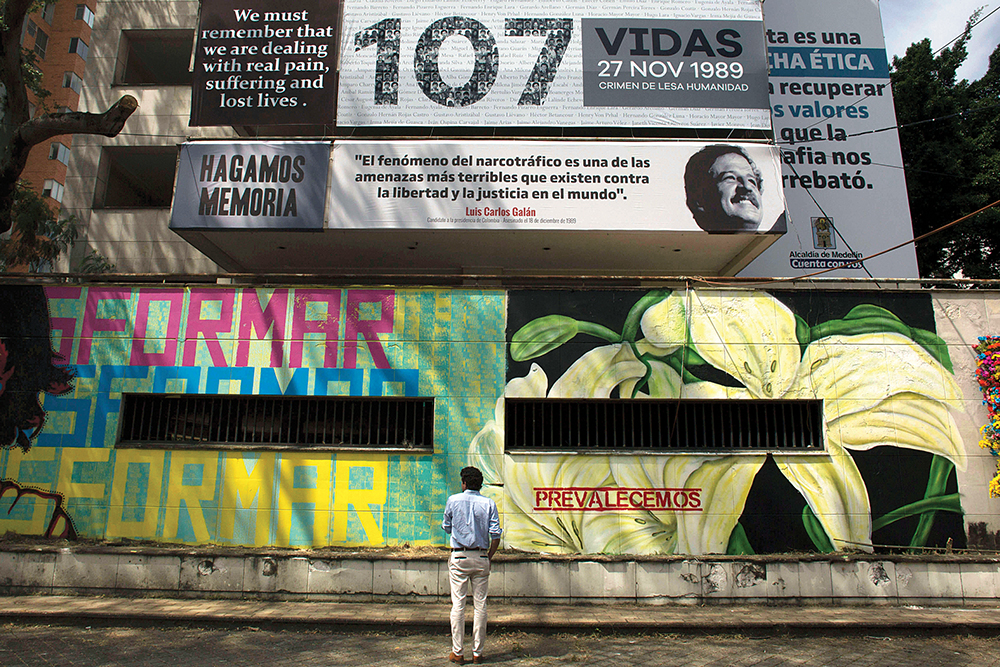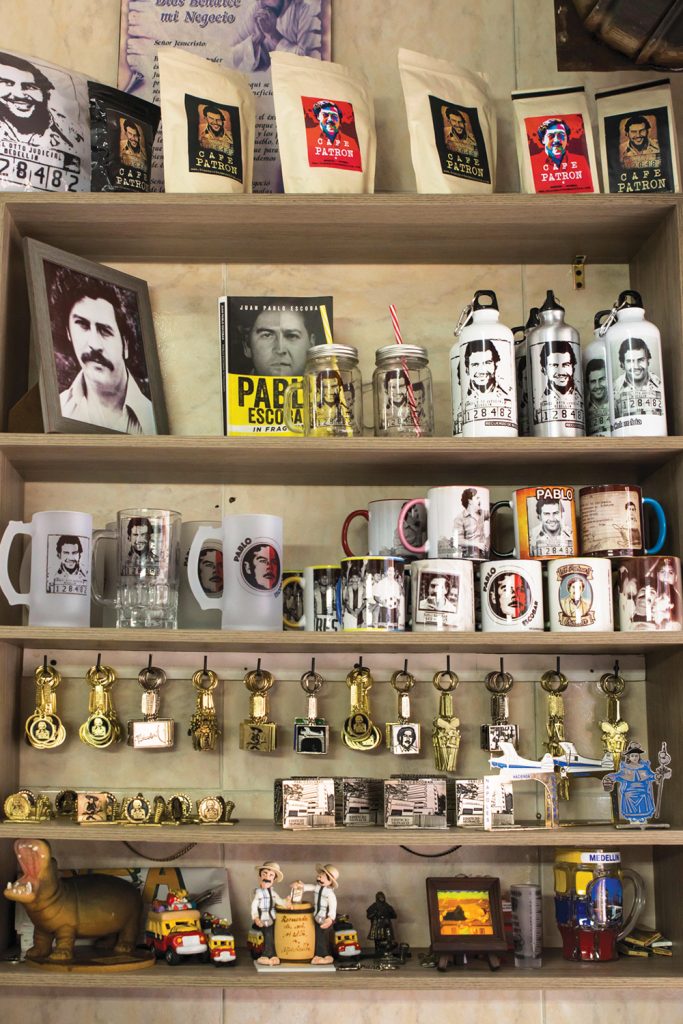
BY RICARDO CASTRO AGUDELO
COUNT TO FOUR. One number per second.
One . . . Two . . . Three . . . Fo . . .
Nearly four seconds. That’s how long it took for the Monaco building to collapse amidst a slow-rising cloud of gray dust on February 22, 2019, in Medellín, Colombia. The Monaco, an eight-story concrete building in one of the city’s wealthiest neighborhoods, was once the bunker/home for narco kingpin Pablo Escobar and his family. That’s before it was abandoned after Escobar’s rivals detonated a powerful car bomb in the vicinity in 1988.
To demolish the building—with its three now-abandoned elevators, tennis courts, swimming pool, sauna, and twelve apartments—the team commissioned for the job deployed 275 kilograms of a dynamite-like explosive. The scope of the operation persuaded local authorities to evacuate over a thousand people from the surrounding area. Nearby, on the grounds of an exclusive country club, the mayor of Medellín, Federico Gutiérrez, had organized a viewing party of sorts. Fifteen hundred spectators, including over 300 of Escobar’s victims, gathered to witness the demolition. The president of Colombia, Iván Duque Márquez, was also in attendance. “I believe this event signifies the defeat of the culture of illegality and the triumph of legality. It means that history will not be written orbiting around victimizers,” Duque said, before mentioning the victims of narco-terrorism. “Today, with their memory in our hearts, we know their sacrifice for Colombia was not in vain. I hope that everyone who comes to visit the monument in honor of the victims sees how Colombia is over that horrible night of the Medellín cartel and how a creative, innovative society has now been built.” The event, which local media described as “historic,” was also televised.

The demolition of the infamous building was part of Medellín abraza su historia (Medellín embraces its history), a wide-ranging campaign promoted by the local government to pay homage to the 46,000 victims felled by the narco war against the state between 1983 and 1994. The building had become one of many visible and undying scars of the city’s (and Colombia’s) recent past, when Escobar’s cartel declared an all-out war against the country’s institutions, making Medellín one of the most violent cities in the world. The building, for years neglected in its abandonment, started gaining notoriety as a result of a newfound international interest in drug baron stories: best-sellers, dramatizations, movies, the Netflix-produced Narcos. Today, Escobar’s face is stamped and sold on any surface, from t-shirts to coffee mugs. The growing memorabilia industry around the cartel has also manifested itself via narco tours, which take foreigners to important sites of the drug war history in Colombia. Of course, the Monaco building was one of the highlights, a premium spot for tone-deaf tourists to show off on social media. This celebratory approach to the life of a killer who caused so much pain persuaded the city officials to act. These acts of remembrance, centered on the thousands of victims of narco-fueled violence, have helped to counter what some perceive as an idolization of criminals and thugs.
Journalism and Remembrance
Minutes after the building collapsed, two thousand miles to the north, in Austin, Texas, Patricia Nieto started talking about remembrance. A soft-spoken journalist, teacher, and writer from Colombia, Nieto was just starting her career when the cartel’s challenge was boiling. The kinds of stories she suddenly found herself reporting were hard to prepare for: bombings, extortion, and kidnappings amidst a rarefied atmosphere of omnipresent fear. She addressed a diverse audience of faculty, students, and fellow journalists gathered at the Benson Latin American Collection on the University of Texas at Austin campus, where the 2019 Lozano Long Conference was under way. The conference—titled Journalism under Siege—focused on the multifaceted perils journalism and its practitioners face when reporting in Latin America.
Experts from the journalism field from around the continent shared their thoughts and experiences over the three-day span of the event. Nieto was featured in a panel discussion, “Journalism, Memory, and the Search for Justice,” alongside human rights attorney and UT professor Ariel Dulitzky, a leading expert on the inter-American human rights system, and Marcela Turati, a courageous Mexican journalist-turned-war-reporter. Nieto began her talk about memory by reading a short autobiographical account of the first time she saw a dead body, at age twenty-two. She visited Medellín’s morgue two days after a car bomb had exploded in the city’s bullfighting rink, where a crowd was gathered. She was there to report on any unclaimed bodies left by the explosion when she saw up-close the body of an unidentified twenty-year-old male. A woman—his sister—told her his story and his name. He was a locksmith and an amateur soccer player who ended up selling crisps on the streets of the city. “She gave back a first name and a last name to he who was silenced as a John Doe.” Nieto saw the sister’s aching hurt, looking at the body of her brother as she cried, cursed, and asked for explanations. “When I saw her embrace the dead body, I saw that she had begun to understand the fate of her younger brother.”

Nieto recalled going back to the newsroom sobbing, unable to make sense of her editor’s instructions or of the cold TV news headlines. “I wanted to go back to the boy and cover him at least with a blanket,” she said. Years later, she reread the piece she’d written, looking for his name. She was shocked to find she had omitted this detail from her writing, and she felt the dead weight of guilt. “I found I was not only incapable of covering his exposed body with a blanket; I had also denied him his name, and in doing so, I contributed to his second death, which is oblivion.”
“We Must Make the Past Newsworthy”
Journalism traditionally has been an urgent job that focuses on the ever-changing present—the “first rough draft of history,” as famously described by publisher Phillip L. Graham. In conflict-ridden societies, novel journalism practices have emerged out of the overlap of traditional reporting focused on the present, and the exploration of the past for the building of collective memories. The present is no longer the exclusive source of news. In Nieto’s words, “we make the past newsworthy.” Journalists who deal with memory travel back in time to the places where stories were previously reported. The passage of time allows them to question their own methods and to reinterpret past events. It allows them to analyze how stories were reported, then to identify and, hopefully, fill in the blanks with the information needed to understand that which seemed incomprehensible at the time. In this traveling back, journalists themselves become primary sources for the stories.
When reporting on the missing, the dead, the victims, journalists face a challenge for which they haven’t been trained. Exploring how past violence has been reported allows them to revisit communities that have survived traumatic events and to explore the consequences. Actions once reported on the spot, eclipsed by the ceaseless news cycle and likely forgotten, have had an impact over the years on the people who suffered them directly: the downtrodden inhabitants of rural towns to whom media tends to pay attention only when tragedies occur. The work of Nieto, Turati, and others shows how journalists are indispensable for preservation of memory in times of conflict, as they seek the facts, scenes, and narratives beyond what is broadcast by official sources of information. It is in these interstices between the official narratives and the unknown victims that journalism executes its urgent political role—as a practice to search for stories and a methodology to rescue them from being forgotten. Therein lies the danger: journalists committed to these pursuits have to be resilient. They must face the precariousness of a field increasingly under threat by budget cuts and the depletion of resources.

Nieto’s own experience is telling about the ways in which journalists shift their methods when reporting on the past, when one must realize that sources of information are also victims. As such, they have a political status demanding a different approach. They want to be heard. In these scenarios, practices like collaborative journalism have the potential to rescue stories from silence and prevent such horrors from reoccurring. “There is a lot that exceeds the cold description of who said what and under what circumstances.” The retelling of past events without the pressure of a deadline or of being the first to “break the story” changes the way stories are reported, researched, and told. Journalists who cover violence during conflict play a role they didn’t bargain for. Inadvertently or not, they revitalize the field and the political implications of reporting about citizens rather than those with power.
The rewards might be less tangible, but more lingering. Naming the horror, exposing the grief, silence, and uncertainty of those who have been hurt and ignored has been shown to be a vital factor in societies struggling for reconciliation. Shining a light on victims could help shift paradigms of societies that commodify the faces of their cold-blooded killers. The unrelenting pursuit of truth, however uncomfortable in the short term, could prevent the next criminal-highlight-tour industry and the decades-late efforts to bury the past under the rubble.
Ricardo Castro Agudelo (Bogotá, 1985) is a PhD student in the Department of Spanish and Portuguese at The University of Texas at Austin. He holds a degree in literature and a master’s in journalism. His research interests focus on creative nonfiction and narratives of violence.
The 2019 Lozano Long Conference, “Journalism under Siege: A Collective Reflection,” held in February 2019, highlighted the collective efforts of notable Latin American journalists to protect their work and report on the region’s most pressing social, cultural, economic, and political problems. The conference was co-organized by faculty members Gabriela Polit (Spanish and Portuguese) and Javier Auyero (Sociology), with co-sponsorship from the Knight Center for Journalism in the Americas.
